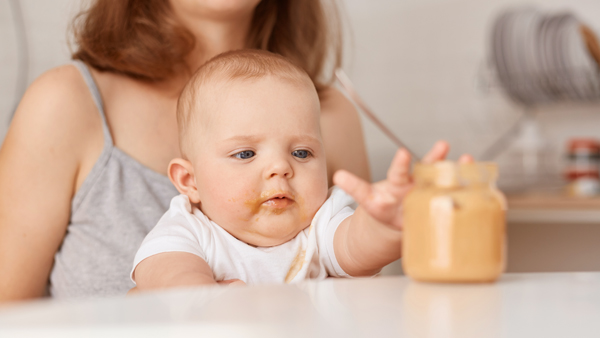What's a normal portion?
A common question when you start giving your baby food is how much is enough at each meal. It's easy to believe that the amount in the purchased baby food jars is what you should give them - but the guide for the right amount is right in front of you: your baby!
4 min read
Verified by Sara Ask
Licensed dietitian
How much is right for your baby depends on the day, how awake the baby is and how much the baby is moving, and what else the baby is eating. For example, how much breast milk or formula have they had during the day? It's something that can vary greatly between babies, even if they are the same age. Some babies have a more adult meal plan with ready-made food at the age of 8 months, while others still have breast milk as their main source of nutrition - and there's nothing wrong with that either. That's why it's not a good idea to compare your child too much with others, but just let your baby be your guide. Does the baby seem well and are they developing normally? Is your child growing as expected? Normal growth is a good sign that the baby is getting enough food and nutrition. If there's any doubt about proper growth, the nurse will tell you.
As a parent, it's easy to try to get as much food in your baby as possible using various tricks, to be on the safe side. You feel better when the plate is scraped clean, the baby food jar empty, or when the last drop in the bottle is sucked down. But for most babies in our part of the world, it's more important to learn what is enough - without tricks that risk stopping your baby from realising when they're full. Research shows that babies have an inherent ability to regulate their energy intake. For example, they adjust the food portions based on how energy-dense the food is. If the food is energy dense, they'll choose to eat a smaller portion and vice versa. It also depends on how many meals they get per day. When babies get fewer meals they eat larger portions than when they get more. This is something to be aware of. One way of thinking about it is that it's the adult that chooses what is served, while the child chooses what and how much they want to eat. Some days this will be more and others less - just as it should be!
For the baby to practice experiencing the food with all their senses from the start and be given a chance to listen to their hunger and satiety signals, it's good to have as few distractions as possible at the dining table. Try to avoid screens, toys and other things that take focus away from the food. Other tips to make the meal as optimal as possible:
Try to time meals so that the baby is hungry enough when it's time for food. A full child won't want to eat. But a child that is too hungry will find it hard to concentrate on what they're eating. Try different things to see what works for your baby!
Try to make sure that there's at least something on the table that the child usually accepts. It's good to add something new too, to expand their food repertoire!
Let the baby have their spoon or the opportunity to pick up food in addition to you feeding them - they usually like it and it's a good step in the direction of becoming an active eater.
Make sure they've got company with others eating - role models are perfect for babies!
Don't have demands and expectations on yourself and your baby, what food to serve or how the meal goes. Stress and food are not good companions. Try to do your best based on the day's conditions - it's ok!
What will the daily menu look like when the baby has started eating?
How long it takes before babies follow a special meal plan varies from child to child, but a good goal is to aim for this when the baby is 10-12 months old. An example meal plan:Breakfast: porridge + fruit purée.
Snack: banana or yoghurt + fruit purée
Lunch: food, homemade or bought, consisting of, for example, pasta/bulgur/potatoes + vegetables/root vegetables + fish/meat/eggs/beans. Follow this with a dessert of fruit or berries.
Snack: a small sandwich with pate or hummus
Dinner: food, homemade or bought, consisting of, for example, pasta/bulgur/potatoes + vegetables/root vegetables + fish/meat/eggs/beans. Follow this with a dessert of fruit or berries.
Supper: e.g. porridge with fruit puree.
Breast milk or formula can be given with the meal if the baby wants it. Provide water with every meal.
Verified by Sara Ask
Licensed dietitian

